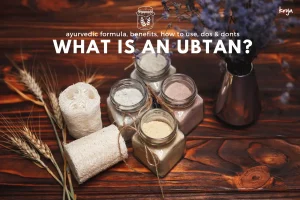We are often asked about the nutrient value of the many herbs we put into our formulations. Our herb display at the Krya Lab fascinates visitors to the Krya facility, and most of them linger on there to touch, smell and experience the herbs. Many of us have been born and brought up in cities where the opportunities to experience and understand the healing power of nature are fewer.
The Krya herb Wednesday series on the Krya blog was born to revitalize our collective interest around herbs and give us a chance to talk about and hopefully demonstrate how diverse, long reaching and powerful herbs are in their action.
We start the Krya Herb Wednesday series with the Mulberry (Morus alba, Morus indica, Morus nigra and other sub species). Krya’s Classic face mask uses the Mulberry Leaf and the Mulberry Fruit.
The Wealth of India, that venerable comprehensive compendium of India’s flora and fauna, lists the Mulberry as a species that is now cultivated across India. An exact origin point is hard to pinpoint . The Mulberry is said to be indigenous across Persia, China, Korea and certain parts of India.
The Mulberry is now cultivated across India for its leaf which forms the primary food for silkworms. The fruits find their way into indigenous cuisine and are delicious and full of nutrient value. The wood of the Mulberry tree is used for the manufacture of hockey sticks, tennis and badminton rackets, cricket bats and stumps. Mulberry bark is also used to make a special kind of paper which has a silk like texture.
The Mulberry in popular culture:
In the plot that clearly inspired William Shakespeare to pen his tale of ill fated lovers, Roman poet Ovid’s Metamorphoses speaks about the star crossed lovers Thisbe & Pyramus. When Pyramus arrives pre-arranged to meet Thisbe under a mulberry tree, he sees Thisbe’s torn scarf with drops of blood on it and assumes in every star crossed lover’s fashion that she is dead, and proceeds to stab himself with his sword. Pyramus’ blood is said to have stained the fruits of the Mulberry a reddish black. Naturally Thisbe does the same when she sees Pyramus’ body. Moved by the lovers’ torments, the Gods themselves change the colour of the Mulberry to represent the blood spilled by Thisbe and Pyramus for their love.
“The Mulberry Tree” is a painting painted by Vincent Van Gogh a year before his death. This painting was done during his year’s stay at the Saint Paul asylum at Saint-Remy. While Van Gogh painted any aspects of his life during his stay at the asylum like the doctors, the hallways, the flowers around the asylum, the wheat fields, etc, he described the painting of the Mulberry tree as his favorite.
In the 1961 Kurosawa film, “Yojimbo” there is a mulberry themed scene that defines the Toshiro Mifune character. When asked his name, Mifune looks at the mulberry fields outside the window and takes the name “Kuwabatake Sanjuro” ( thirty year old mulberry field). His no –nameness defines him. This proved so popular that Kurosawa made a sequel called “Sanjuro” the next year.

Nutritive value of Mulberry Leaf:
The Mulberry leaf is extremely high in protein content, especially tender leaves. As the leaf ages, its protein content decreases and is carbohydrate content increases. This could explain why silkworms generally pick and eat tender mulberry leaves. Studies show a direct correlation between the strength of the silk produced and the composition of the leaves that are eaten / fed to the silkworm.
Because of the high protein content of mulberry leaf, research indicates that it could make a good nutritive supplement to diets that are protein deficient.

The leaves are also a good source of ascorbic acid – 100 gm of dried leaf contains upto 200 mg of ascorbic acid. The leaves also contain carotene, Thiamine, folic acid, folinic acid and Vitamin D. The leaves have also been studied to contain Glutathione, an important anti-oxidant that helps prevent free radical and heavy metal damage to the cellular structure.
Mulberry leaves are also a rich source of calcium, potassium, phosphorus and silica.
We use the Mulberry leaf in the Krya Classic face mask for its anti oxidant and free radical damage limiting action. Through its regulation of melanin synthesis, the Mulberry leaf could with frequent use, help clear up small blemishes and dark spots on skin.
Nutritive value of Mulberry fruit:
Mulberry fruits are eaten fresh or made into jams, tarts and juices. Fresh mulberries contain 88% water and are said to be a low calorie snack as a standard cup (140 gm). Of course as they are usually consumed dried, this makes them less low calorie. At 12% protein content in their dried form, they are considered a relatively high protein fruit. Mulberry fruits are also an excellent source of Vitamin C, Iron, Vitamin K1, Potassium and Vitamin E.
Vitamin C and Vitamin E are vitamins that are important for skin health. Vitamin C is important for general skin health and Vitamin E helps in limiting oxidative damage.
The Mulberry in Traditional Chinese Medicine (TCM) :
Reading up on TCM is always of interest to me. It is an equally ancient system of Medicine and is said to be atleast 2500 years old. TCM has many parts to it that are very similar to Ayurveda including herbal medicine, massage, exercise and emphasis on right eating.
Acne is considered an imbalance of heat in TCM, similar to Ayurveda which considers it a pitta imbalance disease. Similarly, blemishes and dark spots are also considered an imbalance in heat. TCM prescribes Mulberry leaf in both these conditions to cool and balance skin.
So there you have it – that’s a brief window into the amazing health and nutritive properties of the Mulberry fruit and Leaf. The Mulberry leaf and fruit are just 2 of the many hundreds of whole herbs we use to make our nutrient dense skin, hair and home care goodies. Our whole herb goodies are completely plant based, use whole herbs that are carefully processed and use absolutely NO synthetics in their making – the result are toxin free, kind on the planet, vegan and cruelty free skin , hair and home care solutions that actually work.
A happy Wednesday and a fantastic week ahead to you from all of us at Team Krya.
Skin not feeling its best? Try the Krya Classic Skin range:
The Krya Classic face wash was one of our earliest launched face care products. We beta tested the product in Jan 2014, and now hundreds of consumers have used and loved the product across different climatic conditions all over India. The Classic skin care range has been designed for normal – oily skin . Consumers love it for how soft, smooth and non-taut their skin feels. Many consumers report seeing a lightening in small blemishes and scars and improvement in skin quality with frequent use. This is one of my favorite skin care products at Krya as well also because of the amazing fragrance it has (which comes with the addition of high quality, Kumaon grown organic Chamomile).

Here are some testimonials:
“Hi Team Krya, am so impressed with your classic face wash that I have officially become ur brand ambassador. My skin has become softer and younger . I am ordering hair care products for me and my daughter rite away. Thanks ” – AK, Chennai
“Krya classic facewash is my staple face wash. I absolutely LOVE IT. “- Surabhi S, New Delhi
“Good morning!!! It’s been almost 2 weeks I’ve been using krya classic face wash..its very very good:) I have lot of black heads on my nose n believe me..it’s come down drastically..I am using it like a pack once in 2 days n face wash twice a day:) the fragrance takes me somewhere else:) thank u.” Anu SH, Bangalore
The Krya Classic face mask (newly launched) contains both Mulberry Leaf and fruit and dried guava fruit. We have designed this mask as an addition to those who use our Classic face wash with Green tea & Chamomile.

This mask (and wash) is meant for normal – oily skin. It helps clarify skin, balance oil slightly, and give facial skin a nutrient boost.
THANK YOU FOR SIGNING UP
Get More Ayurvedic wellness advice
with




